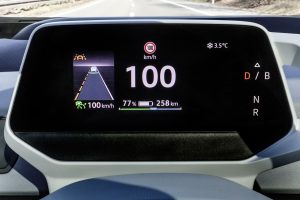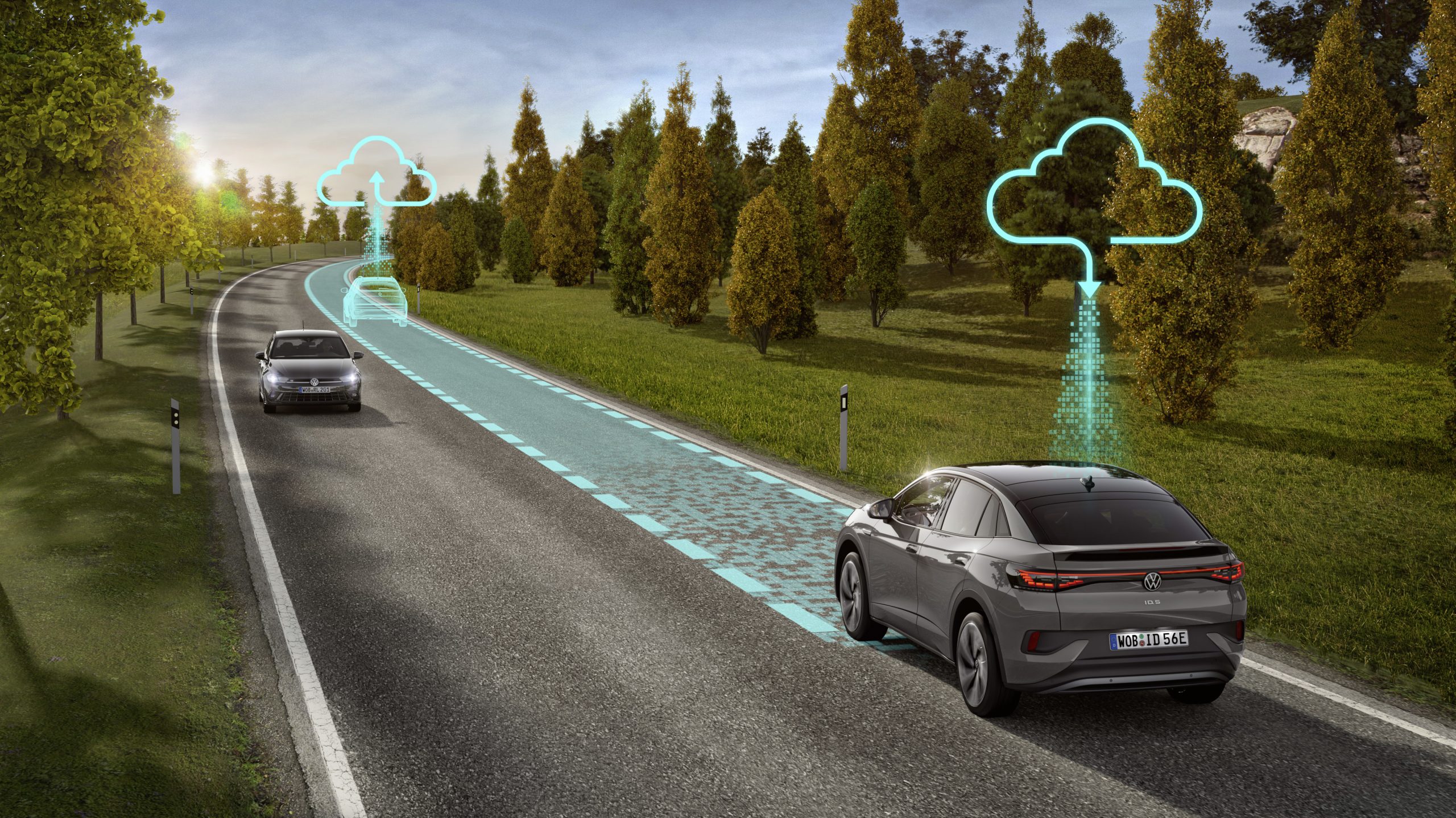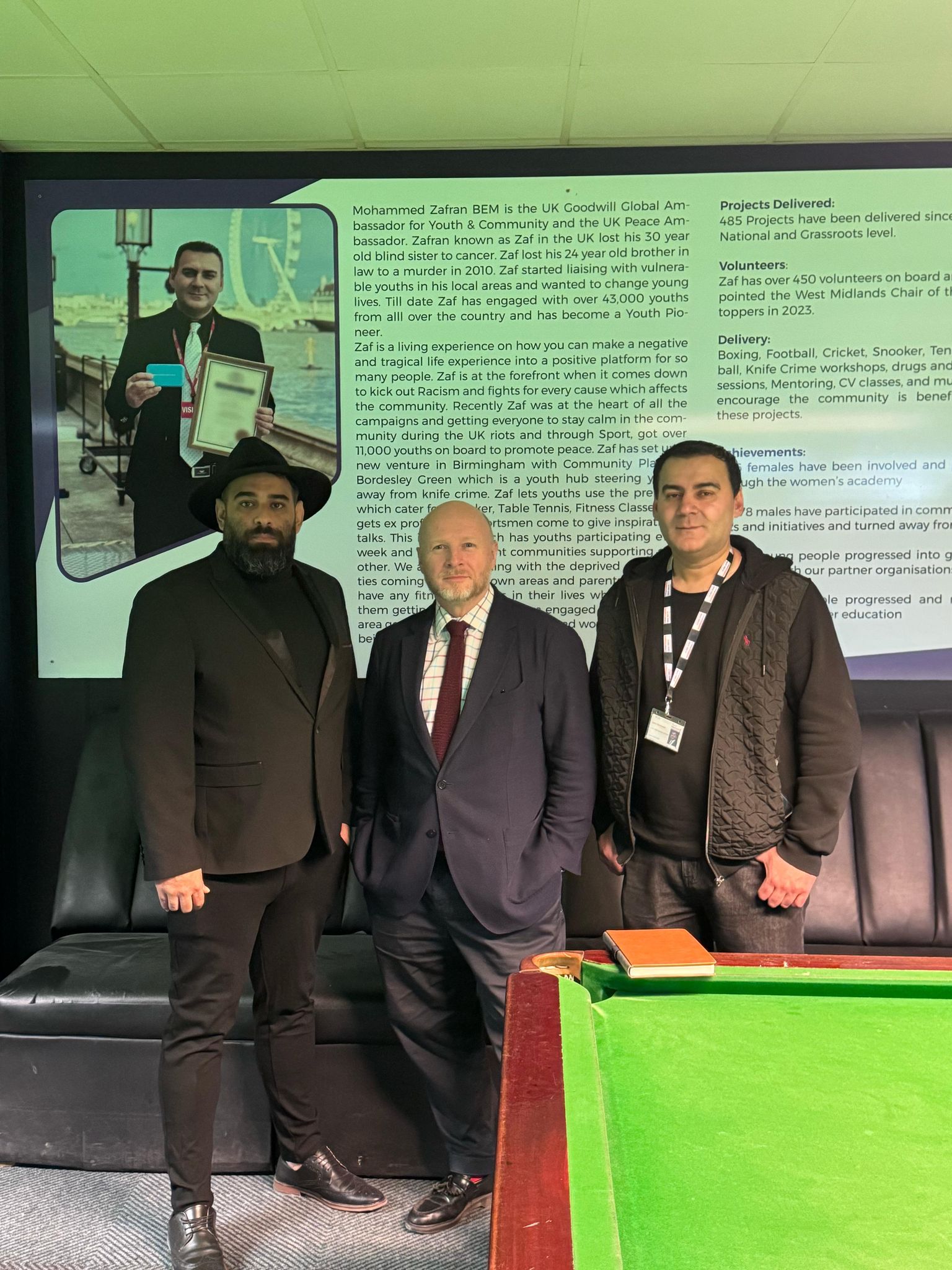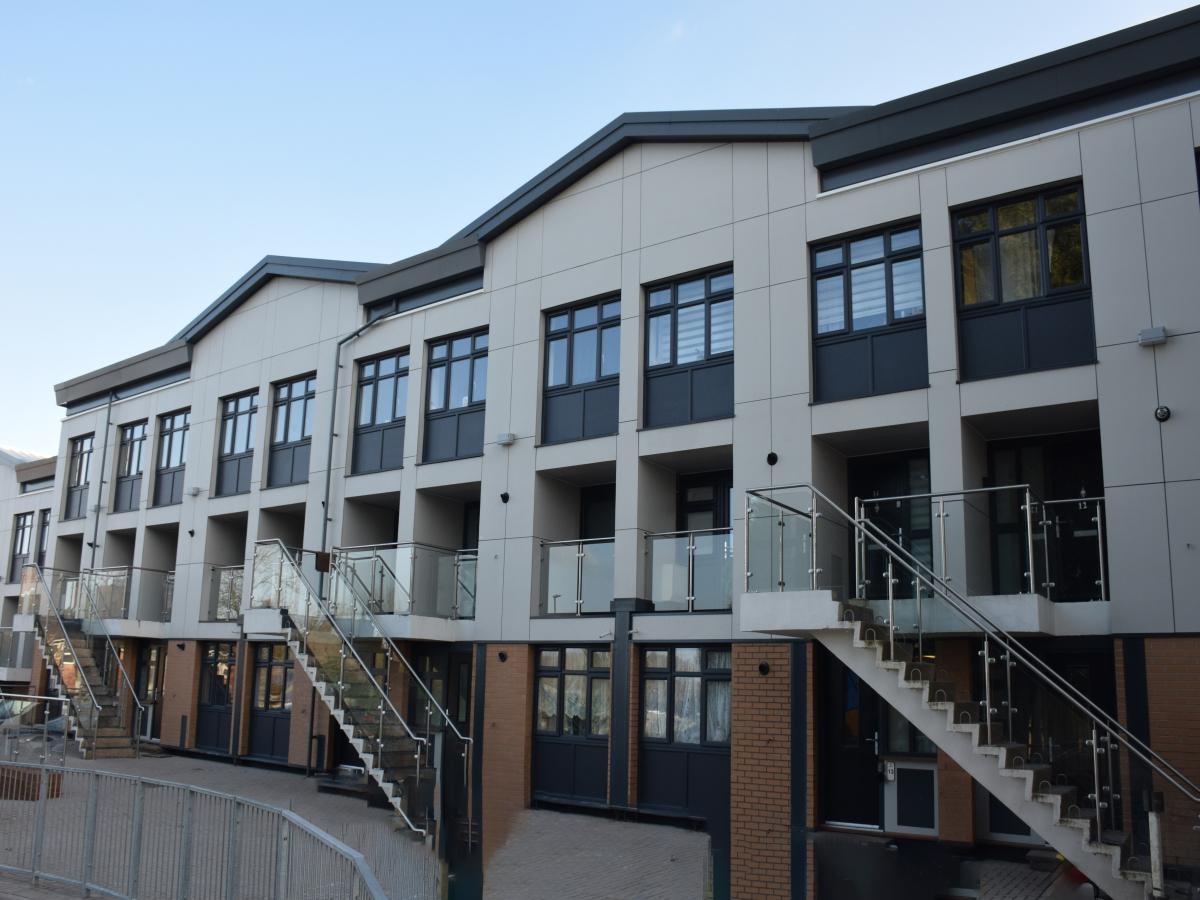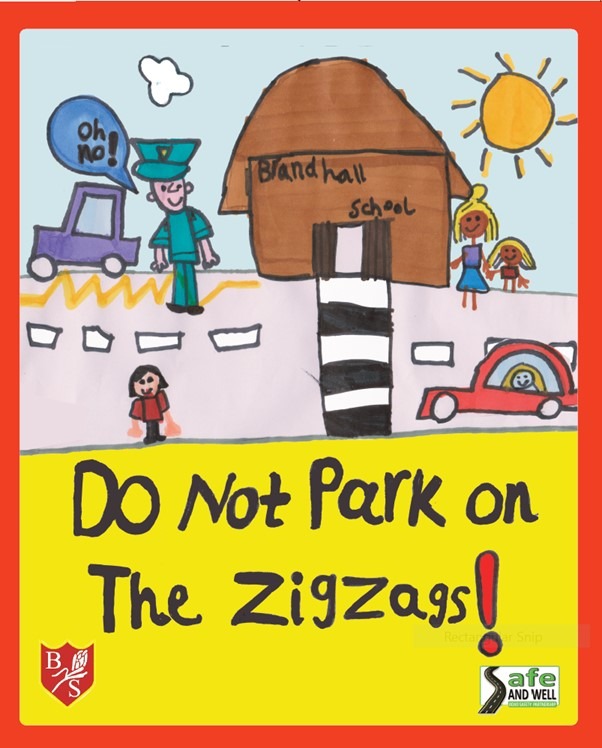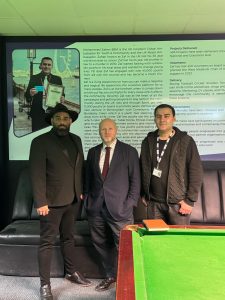A new level of driving: with software generation 3.0, Volkswagen is adding a multitude of new functions to the all-electric ID. models, enhancing user experience and optimising charging capacity. By using swarm data and the most recent generation of driver assistance systems, Volkswagen is also taking the next step towards automated driving. As part of the ACCELERATE strategy, Volkswagen is forging ahead with its transformation to a software-oriented mobility provider – and is becoming an expert in software integration and over- the-air updates. The ID. family is pioneering the way. Buyers of new cars will benefit from the new software right away. For owners of cars that have already been delivered, Volkswagen plans to provide many of the optimisations of ID. Software 3.0 free of charge via an over-the-air update as of Q2.
The new ID. Software 3.0 is an upgrade for our whole ID. family: we are taking our products to a new level of functionality because we are working faster, are more connected and are more customer-oriented,” says Thomas Ulbrich, Member of the Board of Management of the Volkswagen brand, responsible for Technical Development. “Again, we are living up to our claim of offering high-quality technologies and innovations in all classes.”
Intelligent driver assistance systems, including “Travel Assist with Swarm Data”1. The optional “Travel Assist with Swarm Data”1 automatically keeps the vehicle in the centre of the lane. It adapts to the user’s driving style and can also drive further to the left or right of the lane instead of exactly in the middle. It can also maintain the distance from the vehicle in front and keep to the preset speed limit. The system has predictive cruise control and turning assistance. The vehicle speed can be adapted to local speed limits and road layouts (corners, roundabouts, etc.).
New at Volkswagen: With two radars at the rear and using ultrasound, the “Travel Assist with Swarm Data”1can keep an eye on surrounding traffic and, at speeds of 90 km/h or more on the motorway, also actively support lane changes if desired. When activated, the lane change can be initiated and carried out by indicating. The prerequisite for this being that the sensors have not detected any objects in the surrounding area and the capacitive steering wheel can sense the driver’s hands. The vehicle will then steer itself into the desired lane. The driver can intervene at any time and take control of the manoeuvre.
If anonymous swarm data from other Volkswagens is available, the new “Travel Assist”1can also provide support on roads where there is only one lane marking. The vehicle simply aligns itself with a detected lane boundary in order to stay in the lane, for example, on country roads without a central lane marking. Swarm data further increases the availability of “Travel Assist” and enhances comfort and support for the customer.
“Park Assist Plus”2. The smart assistant “Park Assist Plus”2can search for a parking space after it has been activated in the parking menu (up to a speed of 40 km/h for suitable parallel parking spaces and up to 20 km/h for bay parking spaces) and complete the appropriate parking manoeuvre. If desired, the assistant can park autonomously with the help of the environment sensors, and take full control of the car, including steering, acceleration, braking and gear changes. For this, the driver stops at the selected parking space, applies the brake and activates the parking process via the start button in the parking menu. “Park Assist Plus”2can also assist with parking manoeuvres that have already been started, by completing the process. It can also pull out of parallel parking spaces.
“Park Assist Plus with Memory Function”2. Another convenient new feature for the ID. models is the optional “Park Assist Plus with Memory Function”2. Using this innovative driver assistance system, the vehicle can be taught up to five different parking manoeuvres. The memory function remembers parking manoeuvres at speeds below 40 km/h with a travel distance of up to 50 metres. For example, for parking in a carport or garage. The driver just has to park once and save the parking manoeuvre.
The vehicle can then repeat the learned parking manoeuvre autonomously. The driver simply has to monitor the process.
New displays. ID. Software 3.0 also brings plenty of innovation to the displays and infotainment system. The optional “augmented reality head-up display”, which projects important information straight into the field of vision of the windscreen, has now been expanded to include additional displays in the long-distance zone: besides showing the optional “Travel Assist”1 assisted lane change, it also displays new symbols such as roundabouts and information on the distance to the destination. The turn arrows now appear much more integrated into the surroundings. In the ID.
Cockpit, in addition to the remaining distance to the destination, the State of Charge (SOC) is also displayed as a percentage, next to a battery icon that shows the charge level. “We are in close contact with our customers via the ID. Drivers Club – for example, many of them wanted the percentage information, so we made it happen,” says Silke Bagschik, CMO of the ID. Digital project unit and Head of Sales and Marketing for the e-Mobility series.
The updated software also improves the optional navigation. It now locates the vehicle precisely in the lane within the system limits, which enables it to recommend changing lanes in good time at motorway junctions and exits. The corresponding indication for the lane change recommendation also appears in the ID. Light – the strip light under the windscreen. New functions have been added and it now also displays local hazard warnings. This service is based on Volkswagen’s Car2X technology: cars network directly and locally with each other via the WLANp radio standard. This enables them to notify each other of critical traffic situations, ranging from broken-down vehicles to ambulances, in real-time.
Optimised voice control. The voice control uses pioneering technology and brings performance to a premium level. It recognises voice commands much faster and more precisely, increasing both user-friendliness and driving comfort. Its natural language character makes the car an intelligent conversation partner. The customer starts the voice control either by touching the steering wheel or by saying “Hello ID.”. The system replies within a few seconds. In addition, the improved recognition quality of the voice control is now at around 95 percent. The system with its digital microphones also recognises whether the driver or the front passenger is speaking, and follows the instructions accordingly, for example, when it comes to dual-zone air conditioning.
The voice control understands general phrases and colloquial questions and expressions (“Where is the nearest Japanese restaurant in Berlin?” or “I’m too warm”), asks questions where necessary and lets you interrupt. The system responds in two ways – online from the cloud and offline from the information stored in the car. The online process ensures a particularly high recognition rate and quality of results, even when searching for special destinations. Voice control is available in all ID. models on the German market, provided the We Connect Plus service is activated.
Charging the 77 kWh battery with a maximum of up to 135 kW3. The ID. Software 3.0 also has major benefits when it comes to charging. Models with the 77 kWh battery can now charge a maximum of 135 kW3 instead of 125 kW at a sufficiently powerful DC charging station. Improvements to the thermal management of the battery make driving even more efficient and can increase the range, especially in cold weather.
Customers who want to conserve their battery can activate the new Battery Care Mode. It limits the SOC charge level to 80 percent.
Smart e-route planner. The charging menu, which now appears on the first screen of the large touch display of the ID. models is structured in a more informative and clear way. For long distances, the online route calculator in the navigation system creates a clever multi-stop route, which gets you to your destination as quickly as possible. It takes traffic and route data into account, as well as the desired SOC upon arrival at the final destination and interim destination. The charging stops are evaluated dynamically and are based on the output of the charging stations. As a result, the route planning may suggest two short charging processes with high power instead of a single long process with low power.
Digital customer experience is becoming a Volkswagen core competency. As the digitalisation of the automobile increases, new interfaces with customers are emerging both inside and outside the vehicle. With its ACCELERATE strategy, Volkswagen has aligned many processes even more closely with customer needs – from the early development phase of the cars, to the range of digital services and visits at service partners. Customer needs and feedback are to be incorporated even more heavily into all stages of vehicle and service development throughout the entire life cycle. This is making the integration of software in the vehicle and the digital customer experience Volkswagen’s core competencies.
With its ACCELERATE strategy, the Volkswagen brand is adapting to the radical changes within the automotive industry early on and consistently. By 2026, the brand will have invested around 18 billion euros in the future topics of e-mobility, hybridisation and digitisation. As part of its global electric offensive, Volkswagen will increase the share of all-electric cars in sales in Europe to over 70 percent. In the USA and China, the corporation is targeting an electric share of more than 50 percent in the same period. To this end, Volkswagen will promote at least one new BEV model each year. The objective being to fully electrify the range of models. Volkswagen is aiming to be net-zero climate-neutral by 2050 at the latest. The corporation is also accelerating the other major future topics: the integration of software in the car and the digital customer experience are becoming core competencies. Volkswagen is using data-based business models to access new customer groups and tap into new sources of revenue. And Volkswagen will make autonomous driving available to many people by 2030. In doing so, Volkswagen is strengthening its positioning as the most desirable brand for sustainable mobility.
1 The driving assistance function can only be used within the limits of the system. The driver must be prepared to override the assistance system at any time, and is not absolved of their responsibility to drive the vehicle carefully. The system can be deactivated at any time. The system can be used up to the vehicle’s maximum speed. Only in conjunction with a navigation system. Only in conjunction with an active We Connect licence. The online components of the “Travel Assist with Swarm Data” can only be used where there is mobile phone network coverage and with the necessary privacy settings. The online component can be deactivated at any time in the We Connect ID. App at any time. The online component of “Travel Assist” is available in the following countries: Austria, Belgium, Bulgaria, Croatia, Cyprus, Czech Republic, Denmark, Estonia, Finland, France, Germany, Greece, Hungary, Ireland, Italy, Latvia, Lithuania, Luxembourg, Malta, Netherlands, Norway, Poland, Portugal, Romania, Slovakia, Slovenia, Spain, Sweden, Switzerland, United Kingdom and Northern Ireland. To activate the online functions, you need a Volkswagen ID user account and must log in to We Connect with a user name and password. Furthermore, a separate We Connect contract must be entered into online with Volkswagen AG. After delivery of the vehicle, you have 90 days to activate the online function of Travel Assist with Swarm Data. At the end of this period, the initial period of use of the online component of “Travel Assist with Swarm Data” of 3 years starts (free of charge). Use of the online component of “Travel Assist with Swarm Data” is enabled via an integrated Internet connection. The associated data costs incurred within Europe are covered by Volkswagen AG within the limits of the network coverage. Additional costs (e.g. roaming charges) may be incurred as a result of data exchange via the Internet, depending on your particular mobile phone tariff and in particular when using the system abroad. In order to provide the service, it is necessary to transmit certain personal data such as the location and IP address of the vehicle. For more information on data processing, see the privacy policy “Travel Assist with Swarm Data”. The availability of the specific services described in the packages may vary depending on your country. The services are available for the agreed contract period and may be subject to change of content or discontinued during the contract period. Further information is available at connect.volkswagen-we.comand from your Volkswagen dealer. For information on mobile phone rate conditions, please contact your mobile phone provider.
2 Within the limitations of the system. The driver must be prepared to override the assistance system at any time, and is not absolved of their responsibility to drive the vehicle carefully.
3 Charging with a maximum of 135 kW DC charging power for the battery variants Pro and Pro Performance, as well as at an ambient and battery temperature of approx. 23 °C and an initial SOC of approx. 5 percent; e.g. at an IONITY station.
4 Photo shows: ID.5 – combined energy consumption in kWh/100 km: 16.2 (NEDC); CO2 emissions in g/km: 0; efficiency rating: A+++.
5 Photo shows:
ID.4 GTX – combined power consumption in kWh/100 km (NEDC): 17,4, CO2 emissions in g/km: 0; efficiency class: A+++.
ID.4 – power consumption in kWh/100 km (NEDC): combined 16.3-15.6; CO2 emissions in g/km: 0; efficiency class: A+++.
ID.3 – combined power consumption in kWh/100 km (NEDC): 14.0-13.7, CO2 emissions in g/km: 0; efficiency class: A+++.
ID.5 – combined energy consumption in kWh/100 km: 16.2 (NEDC); CO2 emissions in g/km: 0; efficiency rating: A+++.
ID.5 GTX – combined power consumption in kWh/100 km: 17.1 (NEDC); combined CO2 emissions in g/km: 0; efficiency class A+++.
The Volkswagen Passenger Cars brand is present in more than 150 markets worldwide and produces vehicles at more than 30 locations in 13 countries. In 2021, Volkswagen delivered around 4.9 million vehicles. These include bestsellers such as the Polo, T-Roc, Golf, Tiguan or Passat as well as the successful all-electric models ID.3 and ID.4. Last year, the company handed over more than 260,000 battery electric vehicles (BEV) to customers worldwide, more than ever before. Around 184,000 people currently work at Volkswagen worldwide. In addition, there are more than 10,000 trading companies and service partners with 86,000 employees. With its ACCELERATE strategy, Volkswagen is consistently advancing its further development into a software-oriented mobility provider.
